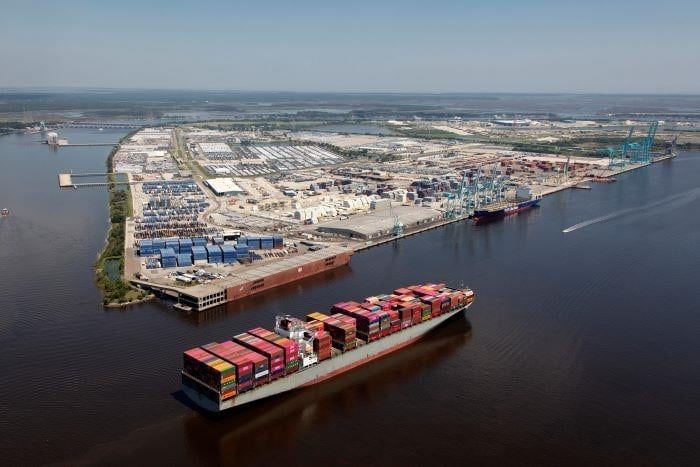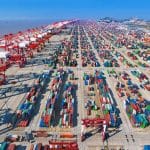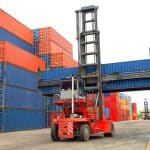JACKSONVILLE LOOKS TO RAISE POWER LINES THAT LIMIT SHIP SIZES

After dredging its main channel to handle larger ships, the Port of Jacksonville now needs to raise power lines that span the channel because they limit the size of the vessels that can readily call the port’s largest marine terminal by acreage. But another Jacksonville marine terminal still faces air draft restrictions due to a bridge that the port has no plans on moving. Jacksonville Port Authority on Monday said 11 miles of the St. Johns River from the Atlantic Ocean up to the Blount Island Marine Terminal have been dredged from 40 feet to 47 feet. The $420 million project would allow post-Panamax ships to transit the channel.
The largest ship that has arrived at Blount Island was a 12,000-TEU vessel on the 2M Alliance’s TP10 service from Asia, but the service more typically uses 8,000- to 10,000-TEU ships. The
port said that the power lines, which are about 175 feet above the river, need to be raised to 200 feet to handle the 14,000- to 18,000-TEU ships that can now transit because of the dredging.
INFLATION COULD RAISE PROJECT COSTS
The Jacksonville Electric Authority (JEA), which owns the lines, released an engineering report this month that estimated raising the power lines would cost about $41 million. However, the report also gave a range of estimates between $33 million and $54 million that stem from the ongoing effects of inflation and worker shortages. The JEA report said that time is of the
essence to achieve the lowest cost on the project because “current supply is very limited and prices are expected to continue to rise, with increases likely to extend well into 2023.
SSA, CERES TO INVEST IN JAXPORT
The port and its marine terminal tenants are making major bets on larger vessels calling both Blount Island and the Dames Point Marine Terminal. SSA Marine, the operator of the 754-acre Blount Island Terminal, is investing $60 million in upgrading the terminal, including the addition of three new container cranes that are expected to be delivered next year. Jacksonville is also undertaking $100 million in berth upgrades at Blount Island that would allow it to handle two post-Panamax ships simultaneously. Ceres has also committed $15 million in upgrades to Dames Point. But that terminal will still face restrictions on its ability to handle post-Panamax ships due to a nearby bridge that imposes a 175-foot height limit on vessels. The port said there are no plans to raise the bridge and that Dames Point’s ability to handle larger ships will depend on tidal restrictions and vessel utilization.
MSC, HAPAG-LLOYD TO SKIP SOME US, CANADA PORT CALLS IN JUNE
Ocean carriers are skipping some calls to Canada and the US East Coast and shifting arrival dates in June as North American port congestion and delays force liners to rework schedules. Mediterranean Shipping Co. said in a Monday schedule update that its Eagle service from Asia, which 2M Alliance partner Maersk offers as its TP1 service, will not call Canada’s Prince Rupert and Vancouver ports during the second and fourth week of June. Along with those two blank sailings, MSC will blank sailings on three Asia services to the US East Coast for one week each during June. Those services include the America/TP17, Empire/TP12, and Elephant/TP11, the update said, adding that the changes were due to “the ongoing challenging market situation generating congestion and schedule delays across the supply chain.” As a hedge against the potential for terminal disruptions linked to the talks, shippers have been diverting more cargo to the US East Coast. But those added volumes are straining ports. The Port of New York and New Jersey said an average of 18 ships were at anchor daily as of last week, waiting for a berth space to open as Asian freight volumes surge. MSC had earlier omitted US East Coast port calls for the Empire service and the Emerald/TP16 service for one week each in June.
SAVANNAH PREPPING FOR SUMMER VOLUME SURGE DESPITE SOFTENING OUTLOOK
The Georgia Ports Authority (GPA) is preparing for a milder peak season this year due to softening demand and a smaller-than-expected backlog of cargo as factories reopen in Shanghai, but the port says it’s in a better position to handle any unforeseen spikes in volume than it was in 2021. A month ago, the GPA was confident the port of Savannah would see another surge in imports from Asia this summer following the lifting of COVID-19 lockdowns in Shanghai. Today, the outlook is murkier. If, on the other hand, the phasing out of lockdowns in China does result in a flotilla of vessels arriving in Savannah, the port believes capacity upgrades to the Garden City Terminal and six pop-up storage sites in the Southeast will allow it to weather the storm. However, the GPA also concedes that the line of vessels waiting for a berth may again rise into the double digits in that scenario.
MORE ON-TERMINAL CONTAINER STORAGE
Inventory levels — i.e., the number of containers in the Garden City terminal per day — have been hovering at about 80,000 containers over the last four weeks. However, the Peak Capacity Project that began last fall to add more than 1 million TEU of storage space to the Garden City yard has helped GPA manage those boxes more efficiently. The Port of Charleston, for example, experienced several terminal congestion in February and March when utilization in the Wando Welch Terminal surpassed 80 percent, causing up to 27 vessels to anchor outside the harbor. The port has since cleared the backlog.
IMPROVEMENTS IN POP-UP YARDS
In addition to those on-terminal enhancements, a new chassis yard under development a mile from the Garden City Terminal on Jimmy DeLoach Parkway will house chassis and empty containers, freeing up land at Garden City for laden cargo. The facility is partially open and will come online in phases this summer. The port authority has already contracted with CSX Transportation to use a terminal in Rocky Mount, North Carolina, and Norfolk Southern Railway to use a terminal in Huntsville, Alabama as pop-up storage sites. GPA says these pop up locations are currently underutilized and ready to accept additional containers.




